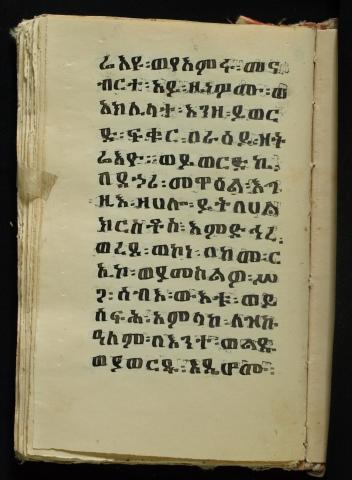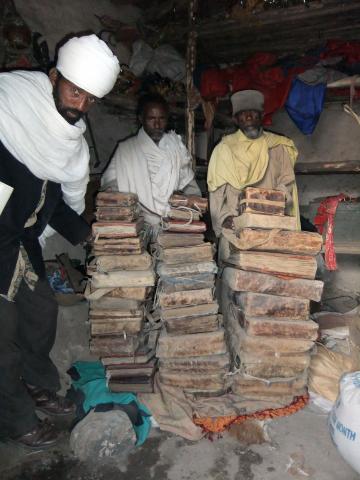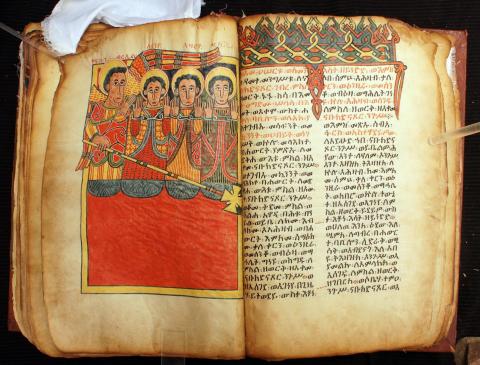Aims and objectives
The objective of this project is to digitise the collection of 98 manuscripts at Däbrä Särabi (Tigray), the maternal monastery of the 14th-15th-century dissident Ethiopian monastic group, the Ewostateans. The collection is of particular historical and art historical value, but extremely vulnerable to damage and loss due to totally inadequate storage conditions.
The collection will be secured in situ by removing insects and dust, and by boxing fragile items. This collection of important and often rare works will be made available to international scholarship through the distribution of digitised copies on DVD and over the internet. Miniatures, marginal decoration and drawings will also be independently digitised which will be of particular interest to art historians. Valuable manuscripts which remain in regular use (during the liturgy and for daily readings) will be photographically reproduced and given to the church as replacements for the originals which will be placed in boxes and held in church storage.
The manuscripts contain material crucial for the study of Ethiopian and Eastern Christian monasticism, the history of Ethiopia, Christian and Ethiopian church literature, and Ethiopian art history in the context of Byzantine and Christian Oriental artistic traditions. Identifiable groupings are:
- Texts relating to the history of the Ewostatean monastic community and its founder.
- Historical documents and notes relating to the history of Ethiopia, 15th to 18th c.
- Eastern Orthodox & Ethiopian Christian literary texts, some little known, or entirely unknown.
- Liturgical texts.
- Illuminated mss. (miniatures, ornaments, drawings).
The collection contains many old manuscripts in a bad condition which will be discarded and replaced either by new ones, or printed editions. Badly worn manuscripts are kept in the abandoned cave-church, condemned to deterioration. Those used for the liturgy are under constant threat - read by candlelight, they become splattered with bees’ wax and are regular victims of fire. Finally, Däbrä Särabi is a frequently visited church inadequately protected against theft. The types of damage recorded include accumulation of mould; ravages of mice; male caterpillar holes; burning; and detached folios.
The monastery was established in around 1300 by abunä Ewostatewos (1273-1352), the organiser of a highly influential Ethiopian monastic movement. The Däbrä Särabi manuscripts are of a particular historical and artistic value. The story of the Ewostateans and its founder, underlines the importance of preserving what remains:
The spiritual movements initiated by Ewostatewos were originally of a clearly dissident character, acting in opposition to civil and ecclesiastic authorities alike. The major point of controversy on the religious level was the addition of the observance of the Sabbath on Saturdays and, on the civic, the forceful plea for independence on the part of the monks from any authority, civil or ecclesiastic. This position, although in keeping with the old teaching of the Apostles, obviously was not shared by the highest representatives of the Ethiopian Church. The prolonged disputes and confrontations, often held at the royal court and in the presence of a ruler, divided Ethiopian society and caused far-reaching consequences in the political and religious life of the country. At some point, the controversies went so far that Ewostatewos and his closest disciples were obliged to leave the country. After appointing leaders to already well-established Ewostatean communities, the refugees went to Egypt where they spent some time living in strict asceticism in the desert of Scetis, famous as the cradle of early monasticism. The group subsequently travelled to Jerusalem, and finally travelled through Cyprus to Armenia. When Ewostatewos died there, some of his disciples joined the Monophisite communities in Syria, while others returned to Ethiopia.
In the 14th and 15th centuries the Ewostateans played a significant role in the christianisation of northern Ethiopia. It was this area which witnessed the widest diffusion of monastic settlements of the “House of Ewostatewos”. Some of them grew into intellectual centres where the theological heritage of Ewostatewos was enriched and elaborated. Many of them established the scriptoria responsible for copying and spreading the Ewostatean writings. The expansion of the movement in the 15th century, along with the growth of its religious and even political influence, contributed to the transformation of attitudes towards the Ewostateans at the royal court and among the ecclesiastic authorities. In the end, this transformation resulted in a change of the dissident monks’ status: during the reign of King Zära Ya’eqob (1434-68) this persecuted minority was enabled to found a renowned monastic school and its theological teaching was accepted as fully legitimate.
Thus Däbrä Särabi, the maternal monastery of Ewostatewos and the place which witnessed the movement’s birth and early development, preserves precious documents which, when accessible to international scholarship, can throw new light on the history of the Ethiopian church and on the political situation of the country in the 14th and 15th centuries. It will also clarify as yet insufficiently researched contacts between the Ethiopian and other Monophisite monastic communities, in particular those in Coptic Egypt, Armenia and Syria.
Digitisation will be carried out in the presence, and with the assistance, of employees of the Office of Tourism and Culture of the Tigray, and of the Centre for the Preservation of Ethiopian Heritage at Meqele University. They will be instructed in the use of the photographic and other recording equipment which will be left at their disposition at the end of the project. Digitisation will also be carried out in the presence of the ecclesiastics responsible for the manuscripts, who at the same time will be instructed on how to care for them.
Copies of the entire archive will be produced and distributed to the following:
- The monastery of Däbrä Särabi
- The Office of Tourism and Culture of the Tigray for the Municipal Library of Meqele (which falls under its jurisdiction)
- The Library of Meqele University
- The Institute of Ethiopian Studies, Addis Ababa University, Addis Ababa
- The British Library
- Hamburg University Institute für Afrikanistik und Äthiopistic (presently the principal centre for Ethiopian studies in the world)
The material will also be made accessible electronically through the on-line database: Mazgaba Se’elet. Information about the accessibility of the Däbrä Särabi archive will be announced on the website of ESF COMSt, the international forum for scholars studying, recording and otherwise dealing with the preservation of oriental manuscripts.
Outcomes
Despite full permissions being given for the digitisation prior to the start of the project, disputes between the local community and the Office of Culture and Tourism of Tigray led to the permission being revoked just after the project was started. Only four manuscripts were digitised before the permission was withdrawn.
Digital copies of the four manuscripts have been deposited with the Office of Culture and Tourism of Tigray in Maqale, the Library of the Spiritans Order in Addis Ababa, the libraries of the University of Toronto Scarborough and Uppsala University, and the British Library.
The records copied by this project have been catalogued as:
- EAP340/1 Däbrä Särabi Collection of Manuscripts [18th-20th century]
Due to the cyber-attack on the British Library in October 2023, the archives and manuscripts database is currently inaccessible and we are unable to provide links to the catalogue records for this project.




